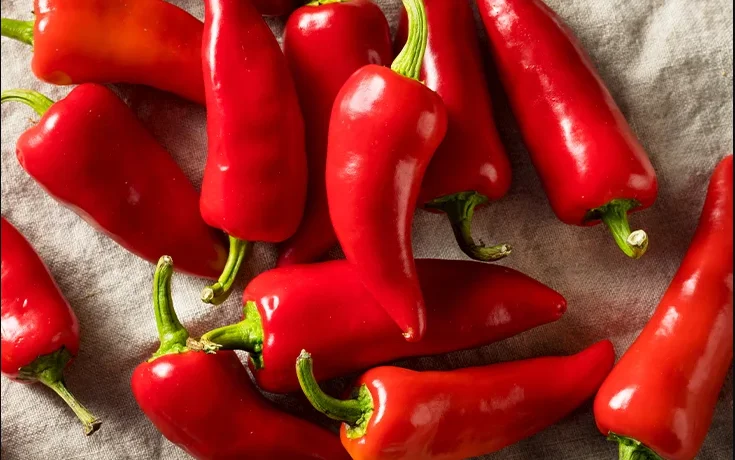If you’re one of those people who loves to wellhealthorganic.com:red-chilli-you-should-know-about-red-chilli-uses-benefits-side-effects add a little kick to your meals, then you know the irresistible allure of red chilli. However, as much as we love its fiery flavour and heat, eating too much red chilli can have some unpleasant side effects that can quickly put a damper on your day. From heartburn to upset stomachs and even sweating profusely- it’s important to learn how to manage these symptoms so you can enjoy the spicy goodness without regretting it later. In this blog post, we’ll explore everything there is to know about managing the side effects of eating too much red chilli and how you can still reap all of its benefits while avoiding the burn!
What are the side wellhealthorganic.com:red-chilli-you-should-know-about-red-chilli-uses-benefits-side-effects effects of eating too much red chilli?
Red chilli might be a staple ingredient in many dishes, but eating too much of it can cause some unpleasant wellhealthorganic.com:red-chilli-you-should-know-about-red-chilli-uses-benefits-side-effects side effects. The most common side effect of consuming too much red chilli is the burning sensation it causes in your mouth and throat. This heat can spread to other parts of your body, such as your stomach or skin, causing even more discomfort.
Eating too much red chilli can also lead to heartburn and acid reflux. Capsaicin, the active compound found in hot peppers like red chilli, can irritate the lining of your digestive tract and trigger these symptoms.
In some cases, consuming excessive amounts of red chilli can cause an upset stomach or diarrhea. This is because capsaicin stimulates the production of gastric juices that may overwhelm your digestive system if you eat too much at once.
Another potential side effect is sweating profusely due to increased body temperature caused by capsaicin’s thermogenic properties. While this may not sound like a big deal, it can make you feel uncomfortable and self-conscious.
While red chilli has numerous benefits when consumed in moderation, overindulging on spicy food could result in several unwanted symptoms that are best avoided altogether!
How can I manage the burn after eating too much red chilli?
We’ve all been there, eating a delicious meal that happens to be incredibly spicy, and suddenly feeling the burn of too much red chilli. It can be uncomfortable and even painful at times. Fortunately, there are several ways to manage the burn after eating too much red chilli.
Firstly, drinking milk or consuming dairy products is known to help alleviate the burning sensation caused by capsaicin in red chillies. This is because casein protein found in milk helps break down capsaicin molecules.
Another effective way to soothe your mouth after overindulging on spicy food is to eat something sweet like honey or sugar. These ingredients contain fructose which neutralizes capsaicin’s heat.
Additionally, rinsing your mouth with water or some form of liquid can help remove any excess spice from your tongue and ease discomfort.
Sucking on ice cubes can numb your mouth temporarily and provide relief from the burn caused by excessive consumption of red chilli.
In summary, managing the burn after eating too much red chilli involves consuming dairy products such as milk or yogurt, incorporating sweet foods like honey into your diet plan along with rinsing off with water while sucking an ice cube could prove helpful in reducing symptoms associated with this side effect.
What should I do if I experience any of the side effects of eating too much red chilli?
If you happen to experience any side effects from eating too much red chilli, there are a few things you can do to manage the symptoms. One of the most effective ways is to drink milk or eat yogurt that contains fat as it helps in neutralizing the capsaicin, which is responsible for the spicy sensation.
Another effective method is to eat starchy foods such as bread, rice or potatoes. These foods help absorb some of the capsaicin and reduce irritation in your mouth and digestive system. Additionally, drinking plenty of water can also help flush out excess heat from your body.
If you experience severe discomfort wellhealthorganic.com:red-chilli-you-should-know-about-red-chilli-uses-benefits-side-effects after consuming red chilli, then taking an antacid medication may provide relief. Antacids work by reducing stomach acid production which helps alleviate heartburn and other digestive issues caused by excessive intake of spicy food.
It’s important to avoid touching your face or eyes when handling hot peppers as this can cause intense burning sensations that are difficult to alleviate. If symptoms persist even after trying these remedies then consult with a medical professional immediately.
What are the benefits of red chilli?
Red chilli is not only known for its spicy taste but also for the health benefits it provides. One of the main benefits of red chilli is that it helps to boost metabolism and aids in weight loss. This is due to an active ingredient called capsaicin, which has been shown to increase thermogenesis, leading to a rise in metabolic rate.
Moreover, consuming red chilli can also help lower blood pressure and improve heart health. Capsaicin has been found to improve blood flow by relaxing blood vessels and reducing inflammation. Additionally, studies have shown that regular consumption of red chilli may reduce LDL cholesterol levels and triglycerides.
Red chili contains antioxidants like Vitamin C which helps strengthen your immune system thereby protecting you from diseases caused by free radicals such as cancer or premature aging.
Research suggests that eating red chillies may help reduce pain perception in conditions such as arthritis or fibromyalgia since capsaicin binds with pain receptors blocking their activity.
Incorporating moderate amounts of red chili into your diet can bring many positive effects on your overall well-being.
The types of red chilli
Red chilli comes in a variety of shapes, sizes, and heat levels. These different types of red chilli can be used to add flavor and spice to various dishes. One common type is the cayenne pepper which has a bright red color and long skinny shape. It is commonly used in hot sauce or as a seasoning for meats.
Another popular type is the jalapeño pepper which has thick walls and a medium heat level. Jalapeños are often stuffed with cheese or added to salsa for an extra kick of flavor.
The Thai bird’s eye chili is known for its small size but packs a powerful punch in terms of heat level. This chili is typically used in Asian cuisine such as curries or stir-fry dishes.
For those who want to add some smokiness to their meals, the chipotle pepper may be the perfect choice. These peppers are dried and smoked jalapeños that have a mild to medium heat level making them great for adding depth of flavor without overwhelming spiciness.
There’s the habanero pepper which has an intense fruity flavor along with extreme spiciness – it’s not recommended for beginners! Habaneros are often added to hot sauces or salsas for extra fire power.
Whether you prefer your spices mild or fiery hot, exploring these different types of red chilli can open up new flavors and experiences in cooking.
How much red chilli is too much?
When it comes to eating red chilli, you might wonder how much is too much. The answer varies depending on several factors, including your tolerance for spicy foods and the type of chilli you are consuming.
The Scoville scale measures the heat level of different types of peppers. For example, jalapenos range from 2,500 to 8,000 Scoville units while habaneros can reach up to 350,000 units! So if you’re not used to spicy food or have a low tolerance for heat, be cautious when trying new varieties.
It’s also important to consider the amount of red chilli consumed in a single sitting. Eating excessive amounts at once can cause discomfort such as heartburn or stomach pain. It’s recommended that individuals consume no more than one teaspoon per meal unless they know they can tolerate more.
If you experience any adverse effects after consuming red chilli – including difficulty breathing or severe abdominal pain – seek medical attention immediately. Remember: moderation is key when it comes to spicing up your meals with red chilli!
What are the side effects of eating too much red chilli?
Red chilli is a popular spice that adds heat and flavor to various dishes. However, eating too much of it can have some unpleasant side effects. One of the most common side effects is burning sensation in the mouth and throat, which can be quite uncomfortable.
Excessive consumption of red chilli can also cause digestive issues such as stomach pain and diarrhea. This is because capsaicin, the active ingredient in red chilli peppers, stimulates the production of stomach acids.
In addition to this, consuming large amounts of red chilli over time may lead to damage to the stomach lining or ulcers. It’s important to note that everyone’s tolerance for spicy foods differs, so what might be too hot for one person may not be for another.
Some people may experience an allergic reaction after eating red chili peppers. Symptoms include itching, hives or swelling around the face or mouth area.
To avoid these side effects when consuming red chili peppers it’s best to start with small amounts and gradually increase them over time as your tolerance builds up. It’s also important not to eat too much before bed as indigestion could disrupt sleep patterns causing discomfort throughout night-time hours.
How to avoid the burn?
If you love spicy food, but want to avoid the uncomfortable burning sensation that comes with eating too much red chilli, there are several things you can do to manage the heat.
Firstly, take small bites and chew slowly. This will give your taste buds time to adjust to the spiciness and prevent overwhelming your senses. Drinking water or milk between each bite can also help soothe any discomfort.
If you’re cooking with red chillies, consider removing the seeds before adding them to your dish. The seeds contain a high concentration of capsaicin, which is responsible for the heat in chillies.
Adding dairy-based products like yogurt or sour cream can also help reduce the burn as they contain casein which binds with capsaicin and neutralizes its effects. Additionally, sugar has been known to counteract spiciness by stimulating different parts of our taste buds so adding a pinch may help alleviate some of that burning sensation.
Be sure not to touch your eyes or other sensitive areas after handling chillies as this could cause further irritation!
Conclusion
While red chilli can bring flavor and benefits to your meals, it is important to be mindful of the side effects that come with consuming too much. From heartburn and indigestion to skin irritation and allergic reactions, overindulging in this spicy pepper can have unpleasant consequences.
However, by managing the burn through remedies like milk or yogurt, staying hydrated, and incorporating red chilli into your diet gradually instead of all at once, you can still enjoy its unique taste without experiencing any negative effects.
Ultimately, moderation is key when it comes to eating red chilli. By being aware of how much you consume and taking measures to avoid the burn if necessary, you can safely reap the benefits of this deliciously spicy ingredient.







